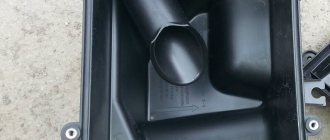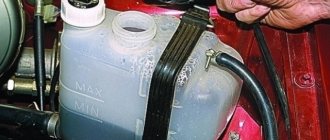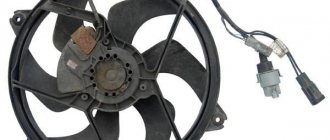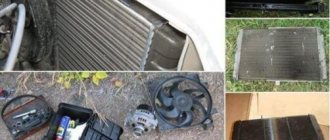We flush the engine cooling system on a VAZ-2110 (review of products)
Of course, all VAZ-2110 drivers are well aware that only 23% of the thermal energy that is released in our combustion chamber is beneficial. That is, less than a quarter of all heat is converted into kinetic energy. The rest of the heat simply warms the engine and escapes into the atmosphere. And, of course, everyone understands that the faster this excess heat is removed from the engine, the more efficiently it will work . This is why our top ten have introduced a liquid cooling system.
When to flush
During operation, the radiator of the cooling system may become clogged. Moreover, it comes from the outside and from the inside. Today, manufacturers are trying to use higher quality materials, but even they do not protect against corrosion and scale.
If the antifreeze used is not replaced in time, it can also negatively affect the condition of the unit. A complex of such phenomena leads to the cooling system becoming dirty and in need of urgent cleaning.
It is not difficult to determine contamination of CO (cooling system) by a constantly overheating engine, regardless of weather conditions.
The frequency of flushing directly depends on operating conditions, engine condition, CO components used, etc.
Causes of pollution
Not every motorist understands the importance of such a procedure as flushing the cooling system:
- Often, car enthusiasts limit themselves to adding or replacing antifreeze, but are very surprised when it turns black after a week
- And the reason is simple - a dirty radiator
- The engine cooling system is designed so that contaminants appear not only from the outside (such as dust, sand or insects)
- But also from the inside (for example: scale, rust, motor oil, as well as sediment from the gradual decomposition of antifreeze)
- A radiator clogged with dirt is no longer able to cope with its main task - cooling the engine; excessive contamination can lead to damage to the radiator and its replacement, and accordingly the cost of repairs will increase!
Engine cooling system flushing technology
To flush the engine cooling system in a VAZ-2110 with your own hands, you must follow the step-by-step instructions:
- Open the filler cap of the expansion tank.
- Place a container under the engine to drain the fluid.
- Remove the bolt from the drain hole located on the cylindrical block.
- The antifreeze that begins to pour out must fall exactly into the container, and not past it.
- When the flow of antifreeze stops, unscrew the cap, which is located at the bottom of the radiator, and again pour the liquid into the container provided.
- Put the plugs in place and pour distilled water inside, adding additives - a substance that will get rid of scale. Alternatively, you can add Hi-Gear product.
- Now rinse the system thoroughly with water, mixing it with the cleaning component. If something does not come out by gravity, it is recommended to clean the surface by exposing it to water pressure. To do this, disassemble the pipeline, freeing the upper component and the base of the radiator from the pipe. As soon as clear liquid flows at the bottom of the radiator, the flow of water can be turned off. This completes the procedure.
How to wash parts of a VAZ-2110
To flush the VAZ-2110 engine, place a hose into the thermostat outlet, turn on the pressure and monitor the condition of the fluid flowing from the engine.
The heating of the car interior depends on the condition of the stove, so it also needs to be periodically cleaned of dirt:
- open the tap responsible for the heater, remove the hoses from the stove unit;
- using the radiator fitting, attach a hose from which a stream of clean water comes out;
- flushing can be completed only when completely clean water comes out of the second fitting.
To avoid unforeseen and dangerous situations when replacing coolant in a VAZ-2110, the driver must remember the following rules:
- Changing the fluid is permissible only after the engine has completely cooled.
- Cooling solutions must be handled carefully, do not forget about the toxicity of the substances.
And finally, before turning on the car engine, close the filler cap.
Special cleaning products
There are special products designed for flushing the cooling system. They are quite expensive, but this is compensated by their high efficiency. Such products contain components that can cope with organic matter, grease, scale and rust. Special means are of the following types:
- neutral. They do not contain aggressive substances, therefore they are mainly used for preventive purposes;
- two-component. The most optimal and popular option for cleaning the cooling system. These products do their job perfectly;
- acidic and alkaline. Most often they are found in diluted form, because they have the most aggressive effect.
When and why to flush
Solving this problem does not require special skills and knowledge, so you can flush the cooling system yourself. It is recommended to do this more often, but even if you perform cleaning once a year, you can achieve a positive effect.
Flushing allows you to avoid the occurrence of various malfunctions associated with the cooling system. The need for this procedure often arises due to the use of low-quality or expired antifreeze, which negatively affects the cooling unit of the car.
Scale in the VAZ cooling system
You can clean the cooling system less frequently if you adhere to the following rules for using antifreeze:
- When draining the coolant, you need to pay attention to its color, by which you can determine the degree of contamination of the system;
- instead of partially adding antifreeze, it is always better to completely replace it;
- The coolant must be renewed at least every two years.
How to wash the cooling system of a VAZ 2110 engine
Flushing the engine cooling system is divided into two types:
- External – the outside is cleaned from dust, insects, and other dirt. Using water or car shampoo.
- Internal – the inside is cleaned from accumulated scale, rust or any accumulated debris. Here the cleaning takes longer and requires force.
You can also flush the system in several ways:
- On one's own.
- Or in the workshop.
If you prefer to just pay money, then it will not be difficult to contact a specialist in any workshop where they will do everything for you. But how carefully and efficiently the master will do it is unknown. Therefore, if you do it yourself, you will not only save money, but also do the job efficiently, which not every master can guarantee.
Simple cleaning products
Almost every owner has distilled water available. It is quite suitable for cleaning the system from simple contaminants. The water washing process is carried out in the following order:
- Drain the coolant and fill the system with water.
- Start the engine, which should run for 30 minutes.
- Drain remaining water.
These steps must be repeated until the water is clear when drained. This method will not help get rid of contaminants such as scale or rust.
You can also use lactic acid, caustic soda or vinegar to flush the cooling system. These products need to be mixed with distilled water, and then the same steps described above are performed. There should not be too much acid, otherwise such a solution can damage the rubber and plastic elements of the car. At the end of the procedure, you need to fill in clean distilled water, which is necessary to clean the system of residual solution.
Cleaning agents and methods
To flush the engine cooling system on a VAZ 2110, you can use different means. All of them have a certain effectiveness and nuances of application.
These tools used today include:
- Distilled water;
- Soda, vinegar, acids;
- Specialized CO purification products.
Now let's figure out what is good or bad about each of the presented options.
Distilled water
Despite everything, distilled water continues to be actively used when flushing the engine cooling system. It is difficult to explain the reasons for its popularity, since this product is not highly effective.
Flushing the radiator with distilled water
The procedure for flushing CO using distilled water is as follows:
- The old coolant is drained;
- Distilled water is poured into the system;
- The engine starts and sits with the engine running for 10, maximum 15 minutes;
- The engine is turned off, after which the distilled water is drained;
- The procedure is repeated until clean water comes out of the system.
The rating for the product is 1.5 out of 5.
Acid, soda, vinegar
This is a more stringent method of flushing the system when compared to using distilled water. However, the level of efficiency is significantly higher.
Cleaning OS with serum
To perform the flushing procedure, you will need:
- Prepare an appropriate solution, which includes caustic soda, lactic acid and vinegar. This mixture is poured into the cooling system. Just do not add too much lactic acid, as this is an aggressive agent that destroys the rubber elements of the CO;
- Then the system simply sits with the acidic liquid inside for no more than 8 hours. Ideally, it should stand for about 6 hours;
- During this period of time, the engine periodically starts and runs for a short time;
- When the specified time has elapsed, drain the acid solution, add distilled water and perform a procedure similar to the first washing method, where only water was used;
- 1-2 rinsing cycles with distilled water will be
- enough to remove all remaining acid solution;
- After this, all that remains is to fill in a new portion of antifreeze.
The rating for the product is 3.5 out of 5.
Specialized cleaning compounds
Go to any automotive chemical store, where you will find entire shelves with products designed for flushing engine cooling systems.
Get ready to spend a significant amount of money on them.
Specialized products are divided into four types:
- Neutral;
- Acidic;
- Two-component;
- Alkaline.
- Alkaline and acidic are considered the most popular because they demonstrate a high level of efficiency, plus from a financial point of view they turned out to be quite attractive.
- Two-component formulations include two main active elements - alkali and acid. They are offered in separate containers, the contents of which are poured into CO one at a time. This allows you to achieve excellent results and forget about a clogged cooling system and an overheated engine for a long time.
- Neutral products do not contain aggressive components. They serve for prevention, since there is no real effectiveness for strong cleaning.
The rating for the product is 4.5 out of 5.
Washing process
Flushing the cooling system on a VAZ 2110 always begins with draining the liquid from the entire system; our instructions will tell you the procedure. So:
- First, open the filler plug of the expansion tank.
- We install a drain container under the engine, then unscrew the drain plug (bolt) located on the cylinder block
Unscrew the plug on the cylinder block
- Antifreeze will flow, make sure that it falls exactly into the substituted container, and not past it
Drain the antifreeze from the engine block
- After the antifreeze stops flowing out, unscrew the drain plug located at the bottom point of the radiator, do not forget to first replace the antifreeze container
Unscrew the radiator cap and drain the liquid into a substitute container.
- Having screwed all the plugs into place, fill in distilled water and add a special additive (scale remover), for example Hi-Gear (photo below)
Additive that dissolves and washes away scale
There are other special products for removing scale and flushing the cooling system; they contain special detergent components in different proportions; however, they have the same properties and purpose:
- They allow you to effectively and, most importantly, carefully (without harm to system parts) remove severe contamination, dissolve the most persistent lime and other deposits on all internal surfaces
- Capable of removing any types and types of contaminants, including oil, in the most gentle way
- The technology for using any such chemistry traditionally ends with washing with water.
After pouring water and detergents, start the engine, let it run a little (seven to ten minutes) so that the product destroys scale and dirt, then drain the water again. You can rinse with acidified water, water with the addition of soda or special salts, but here it is important not to overdo it with concentration, otherwise it will corrode the radiator and pipes and other parts. To completely and efficiently clean the cooling system of your engine, you now need to perform three simple steps in sequence: first rinse the radiator with clean water, then rinse the engine completely, and do not forget to rinse the heating radiator. On the VAZ 21101 the cooling system is flushed in the same way.
Radiator flushing
After flushing using special means, it is necessary to rinse the system with water in order to forcefully wash away contaminants that did not come out when drained by gravity. For this:
- After we have completely drained the liquid from the system, we disassemble the piping system by removing the pipe from the top of the radiator and from its base.
- We need good water pressure, insert a flushing hose into the upper radiator pipe
- We turn on the water pressure to ensure high-quality flushing of the radiator, while monitoring the flowing liquid; if clean water flows from below the radiator, turn off the pressure
Engine flushing
The engine is washed using the same hose:
- Insert the hose into the thermostat outlet
- We give pressure
- We monitor the water flowing from the engine
- As soon as clean water comes out, without scale and cloudiness, from the lower pipe, stop washing
Cleaning the heater radiator
Cleaning the stove (see How to wash a VAZ 2110 stove in several ways) is just as necessary as other parts; you will have to tinker, but it will help to avoid problems with heating the interior later. So:
- Open the heater tap, then remove all hoses from the heater
- We use one of the radiator fittings, to which we attach a hose with clean water pressure
- We flush until clean water comes out of the second open fitting.
It is important to know how to properly drain and refill coolant in domestic car models in order to avoid accidents:
- Drain and add fluid after the engine has completely cooled down.
- All coolants are toxic (poisonous) and should therefore be handled with care.
- Be sure to check the condition of the filler (expansion) tank cap before starting the engine, it is important that it is tightly closed
Procedure for draining and filling coolant. So:
- We advise you to lift the front of the machine up a little, but it is also possible in a horizontal position, before draining the liquid
- Remove the terminal from the battery
- After this, remove the plug from the expansion tank and drain the cooler
- Place a container under the engine to drain the antifreeze, even if you do it outside. Only then unscrew the cylinder block drain plug.
- When the liquid stops flowing, you need to open the plug at the bottom of the radiator. Place a container under it too
- Wait until the liquid is completely drained from the system, and only then tighten all the plugs
Correctly filling the system with coolant
It's time to fill the cooling system with fresh fluid. To prevent air pockets from appearing as the filling progresses, preventing the system from being filled completely, you must perform the following steps:
- If you have an injection engine, you need to loosen the clamp and remove the hose that supplies fluid to the heating pipe of the throttle pipe
- If the engine is carburetor, remove the hose that leads to the carburetor heating tube
Feel free to add liquid to the system; liquid is poured only through the expansion tank, then it will be correctly distributed throughout the entire system:
- As you top up, take pauses so that the liquid has time to fill all outlets and niches
- When the liquid level in the tank stops in the area where it is attached and stops settling, this means that the cooling system is completely filled, you can close the tank lid
- Now we return the hoses to their place
After this, you need to drive the engine to disperse the liquid:
- Start it, let it warm up to operating temperature so that the cooling fan starts working
- Now turn off the engine and look at the fluid level in the expansion tank
- After the engine is running, the system additionally absorbs some more coolant.
- Add fluid to the required level
In the first days after cleaning the system and changing the fluid, it is necessary to monitor the operation of the system and the temperature of the fluid; it is reflected on the instrument panel. If you notice that the temperature rises to a critical level, the arrow moves into the red zone, but the fan does not start, immediately turn on the heating system and check the air flow coming out of it:
- If the air is hot, the fan is most likely faulty.
- When the air flows cold, but the temperature is high, this indicates the presence of an air lock in the system
Removing air lock
The simplest but most effective way to remove air from the system is to drive the front of the car onto a hill so that the engine stands slightly at an angle and runs for a couple of minutes. you should increase its speed to an average level. This usually removes the air lock, but there are more difficult cases, then you need to do the following:
- We remove the cooling pipe from the throttle assembly, which goes to the return flow
- Add liquid to the reservoir
- The liquid should flow through the throttle body tube (if liquid flows, then plug the fitting with your finger and wait until the liquid flows out of the hose)
- If fluid does not flow, start the engine and plug the hose with your finger.
- It is necessary to wait until the liquid appears from the throttle body tube
- As soon as the liquid starts to flow, close the fitting and hold it until the liquid comes out of the hose
- Pull the pipe and firmly clamp the clamp
- We start the engine again and warm it up, using the heater as an indicator
- If hot air comes out, everything is fine
- Add liquid to the expander as needed
The VAZ 21102 cooling system is washed in the same way and the plugs are removed. At this point, flushing the system is complete; additionally, watch our video.











